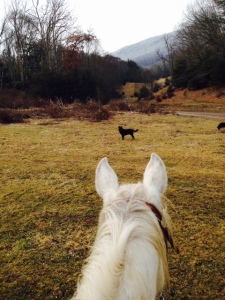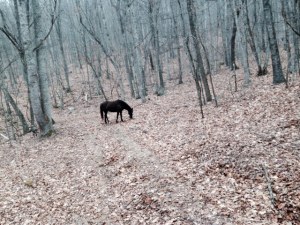Sunday, January 25, 2015
Monty Roberts believes there are 6 imperatives for the riding horse. No matter what the discipline is, there are six basic things that a horse must reasonably do for one to be able to ride: “It is absolutely essential that your horse go forward, be able to turn left and right, stop, back up, and stand still.” Today, Khaleesi and I went back to the arena and I am ready to say that she has at least a basic level of all six. I am now confident that I can make her walk forward, we have steering (left and right) – though it’s not power steering- it’s basic understanding of turning both directions, and I can make her stop, stand still, and yes- we can even back up.
I heard Monty Roberts do an interview not long ago where he talked about the research he has been doing on ritualistic habituation. I can’t say I completely “get” it, but the basic concept I picked up was that horses do best when learning one skill only- until they “cannot get it wrong”- then build on that skill one more skill at a time. This was so specific that he even insisted doing only ONE SIDE of the skill for that work session. [equine speak note: you have to teach horses things on each side separately. For example if you are able to ask the horse to step over with pressure on the right, you cannot assume she will transfer that information to step over with pressure on the left without practicing that side separately.]
I have decided to give this approach a go, and the last training session we rode in the arena about two weeks ago I ONLY worked on going around the arena in one direction focusing on her left steering as much as possible. Last weekend I decided not to work with her under saddle because she came in with a strange swollen cut on her mouth/lip and though she seemed fine overall I didn’t want to take the chance something with the bit or reins might come in contact with the wound and hurt. My hope for this horse to have positive experiences as much as I can control to keep her as interested in working for me. Now that she was healthy again (face wound healed) my goal for the day was to start with the direction we finished in our last session and hope that she “couldn’t get it wrong” and then turn her and begin working in the opposite direction and work on her right side steering.
Getting “selfie” video is a little tricky, but I can set my phone up on the fence and if I end up in that zone there is at least some footage. Both the “stop” and the “stand still” imperative is pretty solid while I get the camera function ready, then I have to lean over to set the phone on the one area of the fence it will balance safely. Unfortunately the part of the arena she always chooses for her argument is outside the zone, so though I know what it feels like, I am curious what it looks like.
The argument…..
Let me back up a step as this is my first post of the riding part of our training. For the winter I have moved my two mares to the farm next door where there is a better shelter for them. At our “home” farm, we have a pulled wire fenced in area that used to be the garden that is a great size for training. I call it “the arena”. We are used to being in that space, and there are no other horses in view here, so less distractions and a little more focus on me. There is a lovely scenic route that is about 2 miles from our winter barn to the arena and I have found it’s nice to take a little pony walk to get there with her in saddle and bit, getting used to her tack, getting some energy out, as well as having to focus on me before we start our work.

Our routine right now is to take a 2 mile walk through the woods to the arena, then I give her a couple minutes break to graze on the good grass while I situate Faygo to hang out while we work. When I’m ready I collect Khaleesi and it takes a couple minutes to explain to her (language gap I suppose) that she is done eating and needs to pay attention to me now. To do this we start with groundwork: walking her around the square exactly how I plan to ride her. If she’s not hearing me (listening to me) she pulls her head away, tries to eat with more attitude and a couple sessions ago even rears up behind me to tell me very loud and clear “I WANT TO EAT- NOT WORK! GO AWAY.” If it comes to that we do some more fast changing intense ground work that pulls her head into the game: back up, walk forward, stop, walk fast, stop, walk normal, turn directions with me, stop, step over, back up… etc… At some point there is a switch where she stops trying to eat and gets in tune with what we’re doing. At that point is when I hop up on her back.
After a few steps with me in the saddle is generally when the argument starts, but only when we are in that same corner of the arena. Each ride the argument is less serious- and never have I thought she was going to hurt me. Here is our script:
Khaleesi (stops and refuses to move): No, I don’t want to walk that direction. I want to stand here and eat grass.
Me (with my legs): You have to walk – this is why we’re in here; and (with my hands): also, I want to go THAT way.
Khaleesi (does little bucks with her back end as I prod her on): I’m going to throw a tantrum and see if you’ll give up.
Me (still kicking and very aware of my breathing- do not get excited, do not yell, calm and focused and fair, if needed sing… how much is that dogggyy in the window…. the one with the wagggin taillllll….): This is a lame tantrum. I am not afraid of you, we’re friends, remember… WE ARE GOING TO DO THIS and I will get my way every time…
Khaleesi eventually: Ok, it seems like it’s easier to just do what you’re asking and not make such a big deal about it. Actually, this isn’t so bad after all.
The first argument a few weeks ago was the worst and I wondered if I might get hurt (the day she reared up while I was leading her), but we worked through it safely and calmly. Each time we work the argument has less heart in it. Today I was ready for it, and it was pretty brief. I continue to gain confidence that I can make her do things, and she continues to learn that I will always make her- so lets not fight.
So.. where were we?
Ritualistic Habituation… right… After three times around the square in the old direction (review the last lesson first) she completely “got” what I was asking. It was solid. Then I decided to turn her around and walk the opposite direction. It’s the same skill, but because it’s the other side- I have to look at it like an entirely new skill, though one she has some reference points for so hopefully the second side will at least be a little quicker. The video shows us walking in the original learned direction (our 3rd time of the day), then I stop her (one imperative) and she stands still (another imperative) while I fix my feet in the stirrups as they had been slipping a bit, then I ask her to walk on (3rd imperative) until we come to the corner the camera is set up, the gate. I always enjoy watching her moving her lips around while she thinks and works. Then we try the new direction. Here is thought bubble play-by-play at that point:
Me: We are going to turn around here and go the other way.
Khaleesi: This is the wrong way, you must be confused.
Me: I hear you, but I think we can go the other direction too.
Khaleesi: If I throw a tantrum or pretend I don’t hear you can we just stop here and eat grass?
Me: No… walk on now.
Khaleesi: Ok.. fine… wait… hey, you CAN go the other way.
I find it interesting how much it took me asking her (this wasn’t an argument, really it was just a conversation) to go the other direction before she settled into it. One reason I like seeing video is being able to notice later how things went as I don’t always remember it fully after the fact when I’m focused on what I’m doing.
TA-DA!
After reversing direction with right hand steering today I can say we have at least a grasp on the 6 imperatives for the riding horse. We have a long way to go in improving control and fine tuning, but I feel good about having the basics in hand now. My next goal in the arena is to ask her to trot for more than a couple steps. The footing was really sloppy today, and I do want to give the “one skill a session” approach an honest try- so though I wanted to push her and start working on trotting around the arena (it’s so fun- she has great trot!) I decided to exercise self-control and end while we were still ahead giving her only one “new” skill to process.
I released her to graze a bit (reward, rest after a good work session) while I went to get Faygo and we returned our two miles home. I think she might have a small bruise on the bottom of one of her front feet. She didn’t appear to be lame on it, but I made a conscious effort to really slow Faygo down and Khaleesi’s pace home. Most of the ground is good, but there are a few patches that are a bit rocky and I wanted to let her pick her way more carefully in case her foot did hurt and to not make the bruise worse. Hopefully with the weekdays off it will improve.
So ends another great day at the farm: two fantastic mares, one more small step towards our goal. AND speaking of goals, I joined the American Endurance Riders Conference [AERC] today. I’m not sure if we’ll able to ride even a “Limited Distance” ride this year, but we are officially members now and for the moment Faygo is my registered horse. I hope we may be able to do a beginning ride and get a feel for how they work.
I hear the weather is supposed to be very cold this week- we are still waiting for winter to rear its ugly head and this year. I have been pretty lucky to do as much riding as I have- eventually Old Man Winter will keep me inside and make riding the horses tougher. Today was a gift!
Till next time……..











